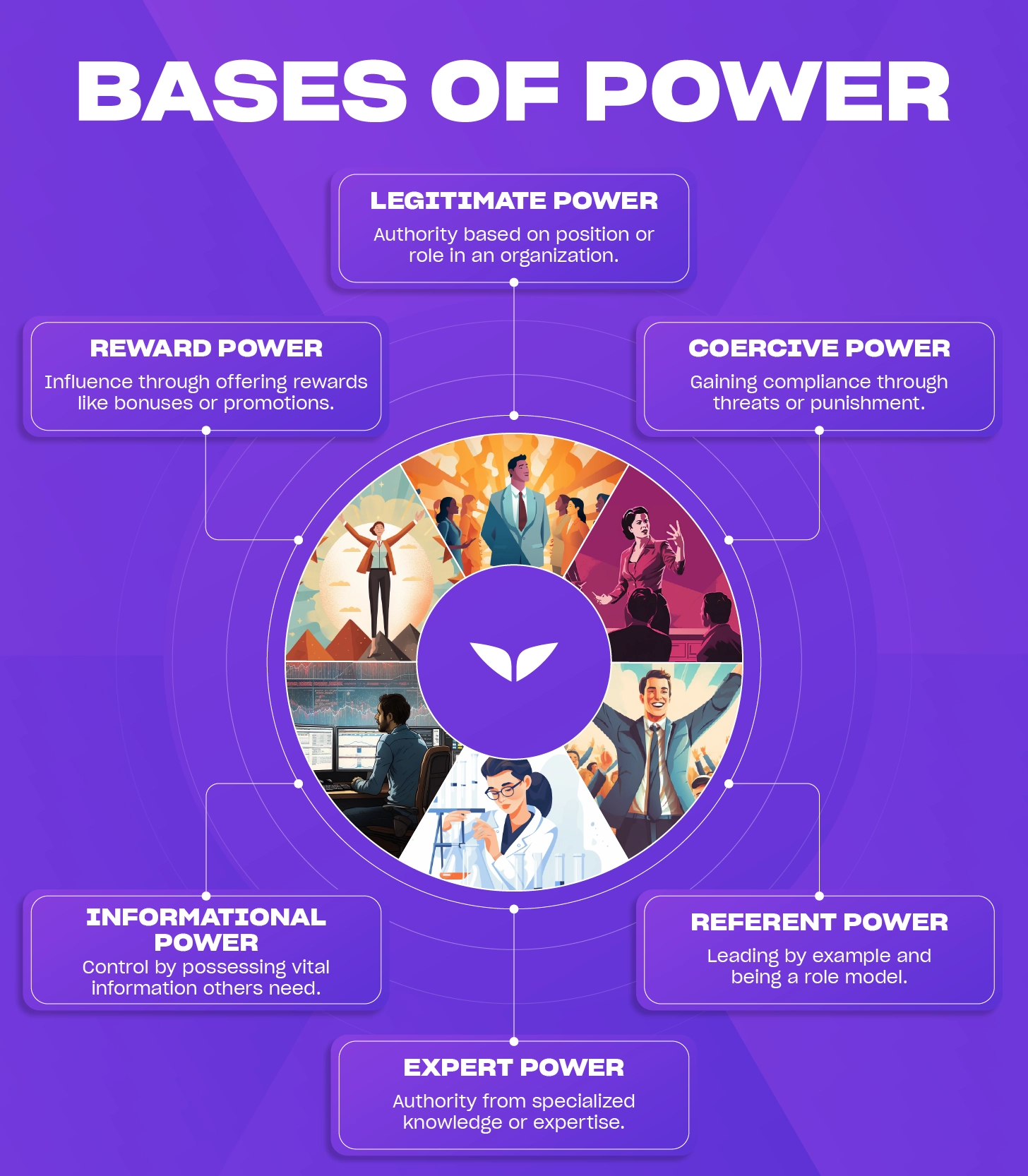One of the biggest sources of strength for a leader is knowing where they draw their power from.
In 1959, social psychologists John French and Bertram Raven identified five bases of power manifested by leaders in positions of authority. Later on, they added a sixth power base to the list to help leaders understand how they can fulfill their roles effectively.
Power bases are the methods by which leaders manifest their power and influence their teams. This is why it’s so essential for them—and for you as their coach—to understand this key concept.
Discover how you can use power bases in leadership as a coaching tool and help your clients lead their teams more intentionally.
What does power mean in leadership?
In the context of leadership, power refers to the ability to influence others. There are different ways leaders can guide, motivate, and direct their teams depending on their style and the organizational culture they operate in.
Power is not just about control or authority but also about the leader’s capacity to affect the behavior, decisions, and attitudes of their reports. They need to skillfully navigate interpersonal dynamics and mobilize their teams to work towards a common goal.
What is the difference between power vs. influence?
When coaching clients on business and leadership skills, it’s important to help them understand the difference between power and influence. This way, they can develop greater awareness of whether they rely on legitimate power (their official position or title) or use influence tactics.
| Power | Influence | |
| Definition | The ability to control or direct others, often associated with authority and position in an organization. | The capacity to affect the thoughts, behavior, or opinions of others, regardless of formal authority. |
| A Typical Example | CEOs using their formal authority to make strategic decisions. | A mentor influencing a mentee through guidance, support, and positive role modeling. |
| Where Power Is Drawn From | Can be derived from formal positions, titles, or roles within an organization (legitimate power), expertise, charisma, rewards, punishment, or control of information. | Primarily stems from personal qualities, relationships, communication skills, and the ability to inspire and persuade. |
| How Authority Is Used | Often involves the exercise of authority and control to achieve compliance. | Involves persuasion, inspiration, and the ability to motivate others voluntarily. |
| Impact | Can be effective as long as the person holds a formal position of authority. | May have a more enduring impact, as it is based on personal relationships and trust. |
What are the different types of power bases?
The six power bases developed by French and Raven can be an essential coaching tool for working with leaders. Let’s look at what each of these forms of leadership is and how they manifest in real-life situations.
1. Legitimate power
This is the leader’s power to get others to comply purely based on their position. In a hierarchical organization, the executives at the top have legitimate power to demand compliance from others.
Although employees may comply based on legitimate power, they might not do so with a sense of cooperation and commitment.
2. Reward power
This is a leader’s ability to yield power by compensating their employees for compliance. In this case, they control a desired outcome for their employees, such as recognition, extra holidays, a bonus, or a promotion.
Used in the right context, reward power can be a strong incentive for employees. However, if overused, employees may be tempted to focus solely on the extrinsic rewards of their work and forget about the more meaningful, intrinsic motivation for their jobs.
3. Coercive power
Using coercive power means making employees comply through force. It can be economic, social, emotional, political, or even physical.
Though these are extreme examples, many leaders use threats (either direct or indirect) to get the work done if they don’t have better leadership tools.
4. Informational power
Informational power in a leader’s hands means controlling critical information that others need. They can exercise this type of power by withholding that information.
However, this type of power dissipates immediately once the information is shared.
5. Referent power
Referent power is a leader’s ability to lead by example. Drawing from this power base allows leaders to earn respect for their values and become role models for employees and mentees.
Leaders can only empower and inspire others if they possess referent power. Naturally, this power base takes more time to develop, and it’s what’s most effective in both organizational and other hierarchical settings.
6. Expert power
Expert power relies on a leader’s specialized knowledge, domain expertise, or skill set. Interestingly, an employee with greater knowledge might have higher expert power when it comes to a particular area.
This power base diminishes as a leader starts sharing their knowledge with their employees. Fearing this, leaders sometimes intentionally choose not to educate their employees.
While this might increase the leader’s perceived power, it weakens the organization’s effectiveness over time, as well as their respect for their leader.

What are some examples of power bases in the workplace?
- Legitimate power: A company’s CEO. Employees are expected to follow the head of the organization’s directives and decisions because of their formal position at the top of the hierarchy.
- Reward power: A manager. They have the authority to grant bonuses, promotions, or other rewards, so employees are motivated to perform well in the hope of receiving these incentives.
- Coercive power: A supervisor. They have the authority to impose disciplinary actions or penalties, so employees may comply with directives to avoid negative consequences such as reprimands or job loss.
- Informational power: An executive assistant. They control access to critical information in a company. Others may seek their favor or cooperation because of the valuable insights and data they can provide.
- Referent power: A popular and respected team leader, well-liked by their colleagues. Team members are more likely to follow their lead due to the positive relationships they’ve built and the admiration they receive.
- Expert power: An IT manager. They have extensive knowledge of cybersecurity, so their colleagues respect and defer to their decisions related to security measures.
The first four power bases are more positional, which means they depend on the role of the leader within an organization.
The last two (referent and expert) are more personal. They stay with the leader, irrespective of their title in the organization; this also makes them easily transferable. Additionally, they’re the most effective at building long-term commitment amongst employees.
Coaching leaders through their power bases
The objective of this coaching technique is to help your clients gain a deeper understanding of their power bases by reflecting on real-life scenarios.
Focus on these two questions during your coaching session:
1. How do they exercise their power right now as a leader?
2. What kind of power would they like to develop more of?
Understanding this concept helps them improve their relationships with their employees and their performance as a leader.
An 8-step process to coaching leaders on their power bases
- Start off by explaining the framework to your client and what each power base means.
- Ask them which one or two power bases they use most often.
- Invite them to think of a specific time when they used them effectively.
- Dig deeper: How much of this power base do they use in their relationships with their juniors, peers, and superiors?
- Can they recall instances when this form of power wasn’t effective?
- What power bases would they like to use more often to become better leaders?
- What are they learning about their relationship with power through this process?
- Is there a dominant power base in their organization or team? How is it affecting their overall company culture?
From insight to action
A leader’s ultimate source of power comes from how effectively they are able to influence their team. Using this powerful coaching model will help your client leave with specific action steps on how they can develop their effectiveness as a leader.
If you want to dive deeper into the art of masterful coaching, join us in the Become a Mindvalley Certified Business Coach free masterclass to learn how to transform your passion into a purposeful profession.








